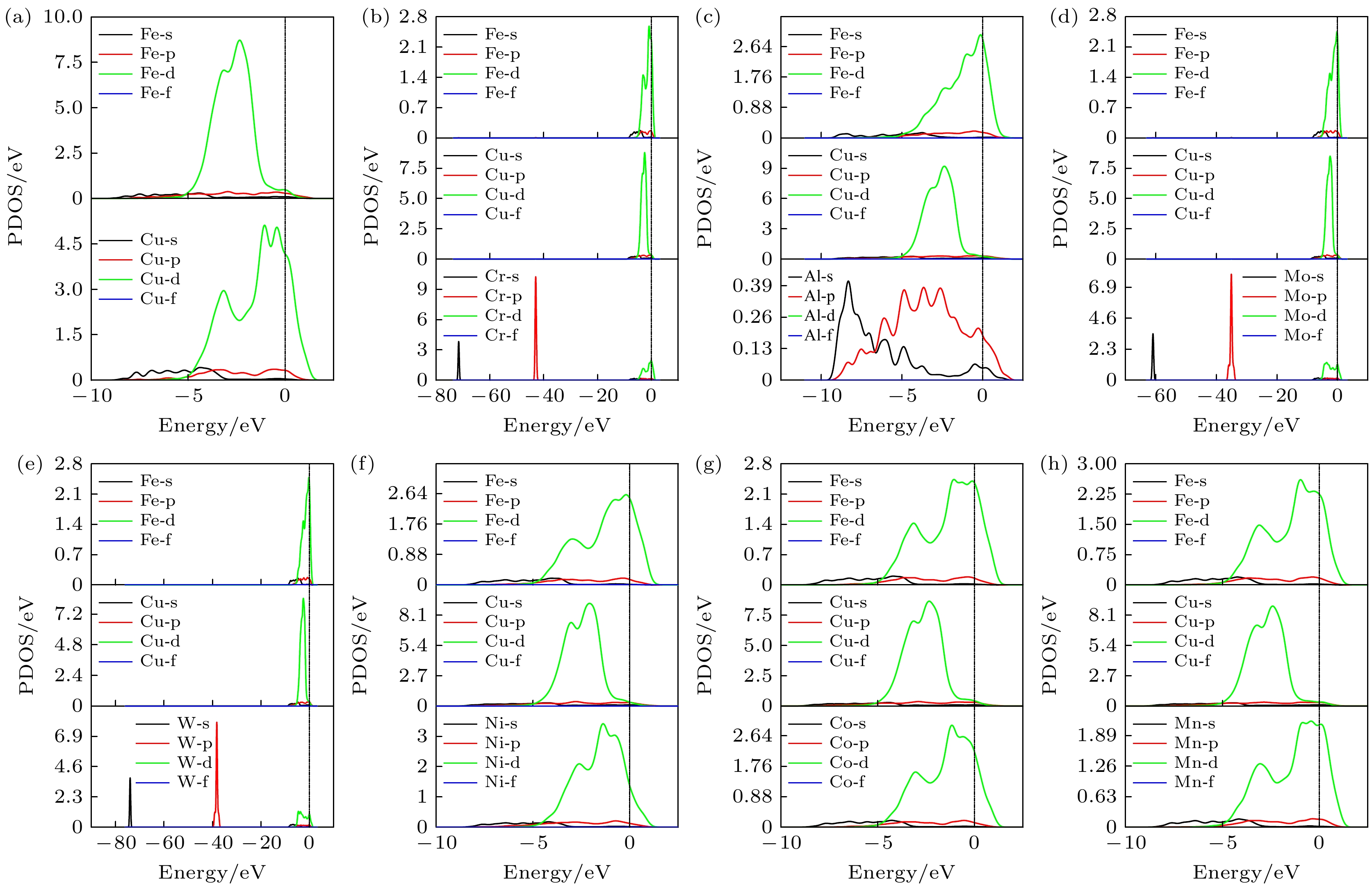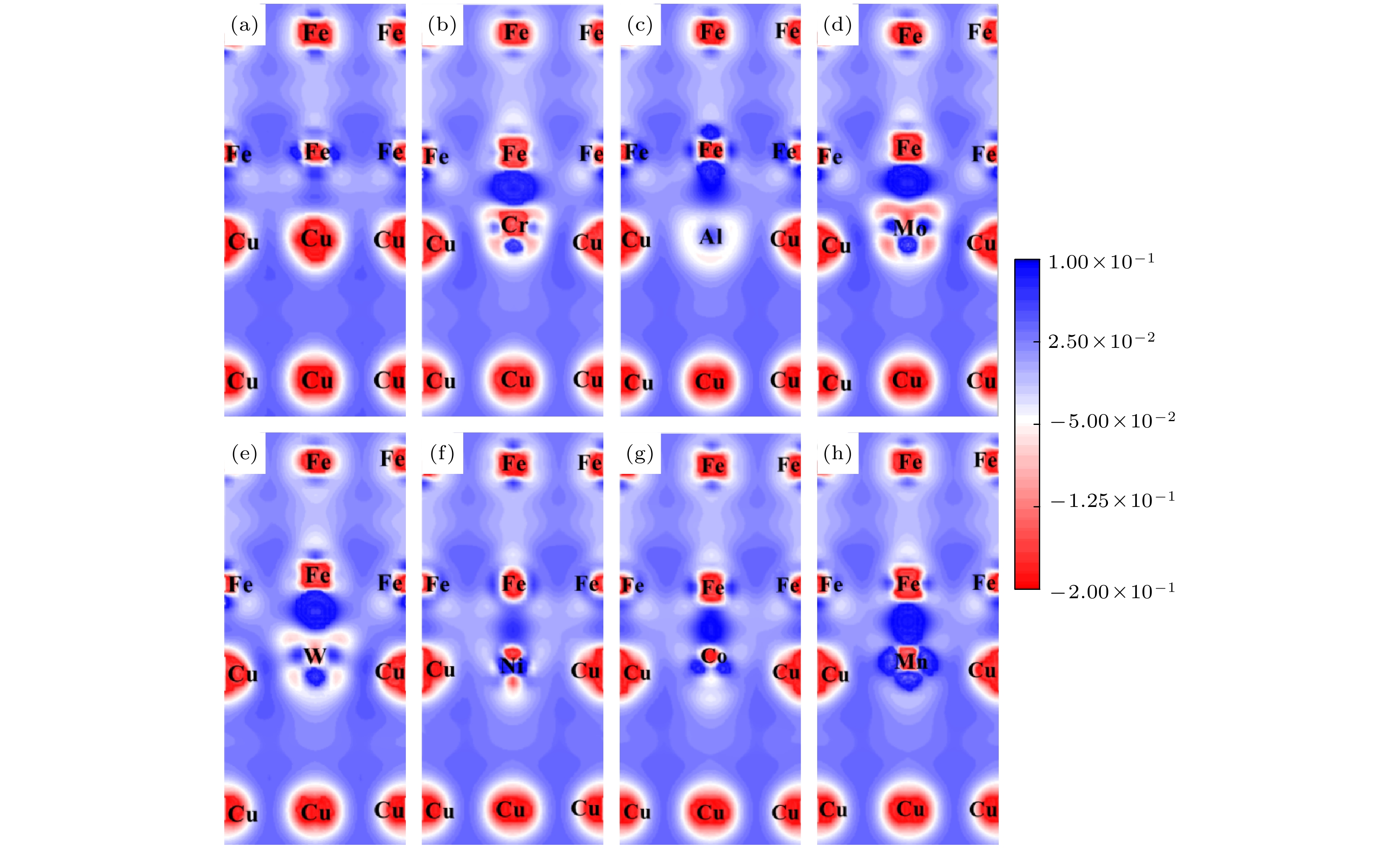-
超高强度马氏体钢的力学性能强烈依赖于逆变奥氏体的形状、尺寸及含量. 通常, 提高逆变奥氏体含量, 有助于改善超高强度钢的塑韧性. 对含Cu马氏体淬火钢时效处理时, Cu粒子会在马氏体组织边界沉淀, 并作为质点促进逆变奥氏体形核. 为了探索不同合金元素对逆变奥氏体在Cu沉淀上异质形核的影响, 本文利用第一性原理方法研究了合金元素 X( X= Cr, Al, Mo, W, Ni, Co, Mn)对Cu/ γ-Fe界面性质的影响, 并分析了合金原子替换界面处Cu和Fe原子前后界面的黏附功、界面能和电子结构. 研究结果表明, 合金元素Cr, Mo, W, Mn替换Cu/ γ-Fe界面处Cu原子时, Cu/ γ-Fe界面处产生强烈的 X—Fe共价键, 黏附功增大且界面能减小, 显著提高界面稳定性, 促进 γ-Fe在Cu沉淀上异质形核. 而替换界面处Fe原子时, 界面稳定性变化很小, 掺杂原子与相邻的其他原子成键较弱.The mechanical properties of ultra-high strength martensite steel strongly depend on the shape, size and content of the reversed austenite. In general, the plasticity and toughness of the materials can be improved effectively by increasing the content of the reversed austenite. After aging treatment of Cu-bearing as-quenched steel with martensitic microstructure, Cu particles precipitate at the boundary of martensitic structure and act as heterogeneous nucleation sites to promote the nucleation of reversed austenite. In order to explore the effects of different alloying elements on heterogeneous nucleation of reversed austenite on Cu particles, the effects of X( X= Cr, Al, Mo, W, Ni, Co, Mn) on the interfacial properties of Cu/ γ-Fe are studied via first-principles method. The adhesion work, interfacial energy and electronic structure of the interfaces before and after the replacement of Cu and Fe atoms at Cu/ γ-Fe boundaries are calculated. The results show that when the alloying elements replace Cu atoms at the Cu/ γ-Fe interface, strong X—Fe covalent bond forms at the Cu/ γ-Fe interface, the adhesion work increases and the interfacial energy decreases, and thus improve the heterogeneous nucleation capability of reverted γ-Fe on Cu particles. When Fe atoms at the interface are replaced, the stability of the interface changes little, and the bonding between the doped atoms and the neighboring atoms is weak.
[1] [2] [3] [4] [5] [6] [7] [8] [9] [10] [11] [12] [13] [14] [15] [16] [17] [18] [19] [20] [21] [22] [23] [24] [25] [26] [27] [28] [29] [30] [31] [32] -
Number of pilsN $ {E}_{\mathrm{s}\mathrm{u}\mathrm{r}\mathrm{f}}^{\mathrm{C}\mathrm{u}} $/(J·m–2) $ {E}_{\mathrm{s}\mathrm{u}\mathrm{r}\mathrm{f}}^{\mathrm{F}\mathrm{e}} $/(J·m–2) 5 1.41 3.79 7 1.44 3.75 9 1.43 3.76 11 1.44 3.75 Atom Total electron/e Transfer charge/e Atom Total electron/e Transfer charge/e Cu 11.14 –0.14 Fe 7.90 0.10 Cr 13.76 0.24 Fe 7.97 0.03 Al 2.89 0.11 Fe 8.04 –0.04 Mo 13.73 0.27 Fe 8.03 –0.03 W 8.01 –0.01 Fe 13.92 0.08 Ni 9.83 0.17 Fe 7.98 0.02 Co 8.74 0.26 Fe 7.96 0.04 Mn 6.55 0.45 Fe 8.00 0 键 键长/Å 键 键长/Å Cu—Fe 2.42 Cu—Fe 2.42 Cr—Fe 2.06 Cr—Cu 2.48 Al—Fe 2.39 Al—Cu 2.53 Mo—Fe 2.23 Mo—Cu 2.57 W—Fe 2.28 W—Cu 2.57 Ni—Fe 2.31 Ni—Cu 2.48 Co—Fe 2.20 Co—Cu 2.41 Mn—Fe 2.13 Mn—Cu 2.47 Atom Total electron/e Transfer charge/e Atom Total electron/e Transfer charge/e Fe 7.90 0.10 Cu 11.14 –0.14 Cr 13.86 0.14 Cu 11.10 –0.10 Al 3.03 –0.03 Cu 11.11 –0.11 Mo 13.90 0.10 Cu 11.20 –0.20 W 14.09 –0.09 Cu 11.19 –0.19 Ni 11.04 –0.04 Cu 11.10 –0.10 Co 8.94 0.06 Cu 11.12 –0.12 Mn 6.67 0.33 Cu 11.18 –0.18 -
[1] [2] [3] [4] [5] [6] [7] [8] [9] [10] [11] [12] [13] [14] [15] [16] [17] [18] [19] [20] [21] [22] [23] [24] [25] [26] [27] [28] [29] [30] [31] [32]
计量
- 文章访问数:3800
- PDF下载量:78
- 被引次数:0














 下载:
下载:




